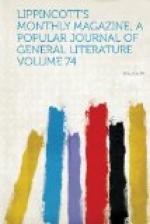“He looks very like a black man in the water when his head comes up,” said Sheila—“when the water is smooth so that you will see him look at you. But I have not told you yet about the Black Horse that Alister-nan-Each saw at Loch Suainabhal one night. Loch Suainabhal, that is inland and fresh water, so it was not a seal; but Alister was going along the shore, and he saw it lying up by the road, and he looked at it for a long time. It was quite black, and he thought it was a boat; but when he came near he saw it begin to move, and then it went down across the shore and splashed into the loch. And it had a head bigger than a horse, and quite black, and it made a noise as it went down the shore to the loch.”
“Don’t you think Alister must have been taking a little whisky, Miss Mackenzie?”
“No, not that, for he came to me just after he will see the beast.”
“And do you really believe he saw such an animal?” said Lavender with a smile.
“I do not know,” said the girl gravely. “Perhaps it was only a fright, and he imagined he saw it; but I do not know it is impossible there can be such an animal at Loch Suainabhal. But that is nothing: it is of no consequence. But I have seen stranger things than the Black Horse, that many people will not believe.”
“May I ask what they are?” he said gently.
“Some other time, perhaps, I will tell you; but there is much explanation about it, and, you see, we are going in to Borvabost.”
Was this, then, the capital of the small empire over which the princess ruled? He saw before him but a long row of small huts or hovels resembling bee-hives, which stood above the curve of a white bay, and at one portion of the bay was a small creek, near which a number of large boats, bottom upward, lay on the beach. What odd little dwellings those were! The walls, a few feet high, were built of rude blocks of stone or slices of turf, and from those low supports rose a rounded roof of straw, which was thatched over by a further layer of turf. There were few windows, and no chimneys at all—not even a hole in the roof. And what was meant by the two men who, standing on one of the turf walls, were busily engaged in digging into the rich brown and black thatch and heaving it into a cart? Sheila had to explain to him that while she was doing everything in her power to get the people to suffer the introduction of windows, it was hopeless to think of chimneys; for by carefully guarding against the egress of the peat-smoke, it slowly saturated the thatch of the roof, which at certain periods of the year was then taken off to dress the fields, and a new roof of straw put on.
By this time they had run the Maighdean-mhara—the “Sea Maiden”—into a creek, and were climbing up the steep beach of shingle that had been worn smooth by the unquiet waters of the Atlantic.
“And will you want to speak to me, Ailasa?” said Sheila, turning to a small girl who had approached her somewhat diffidently.




